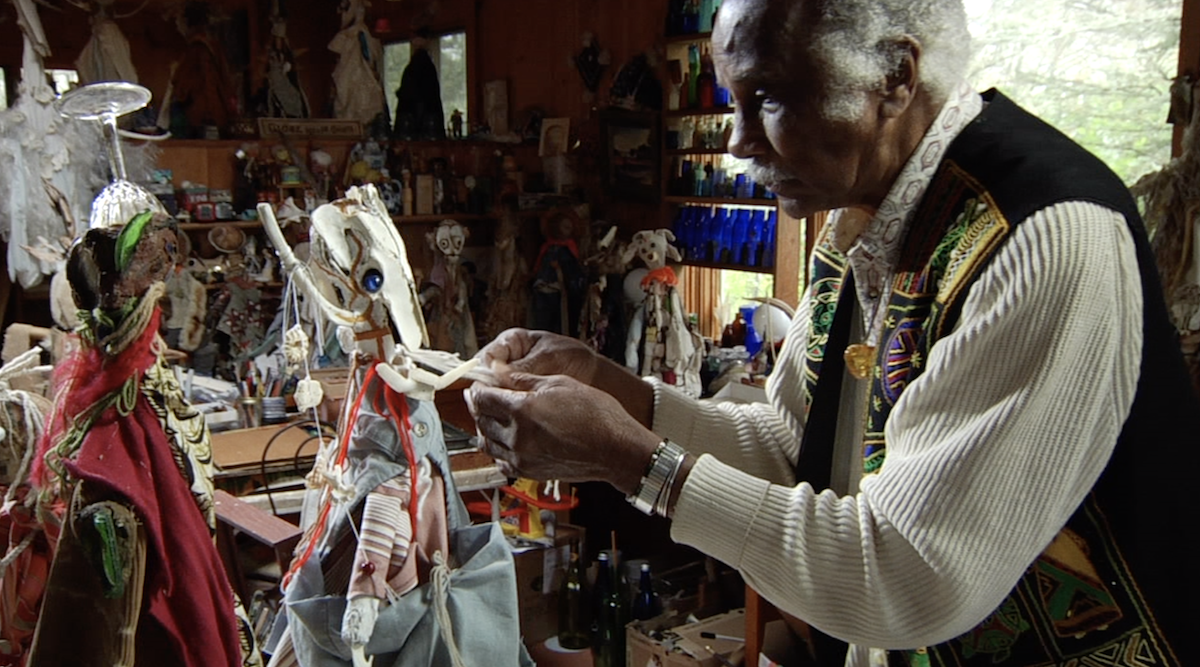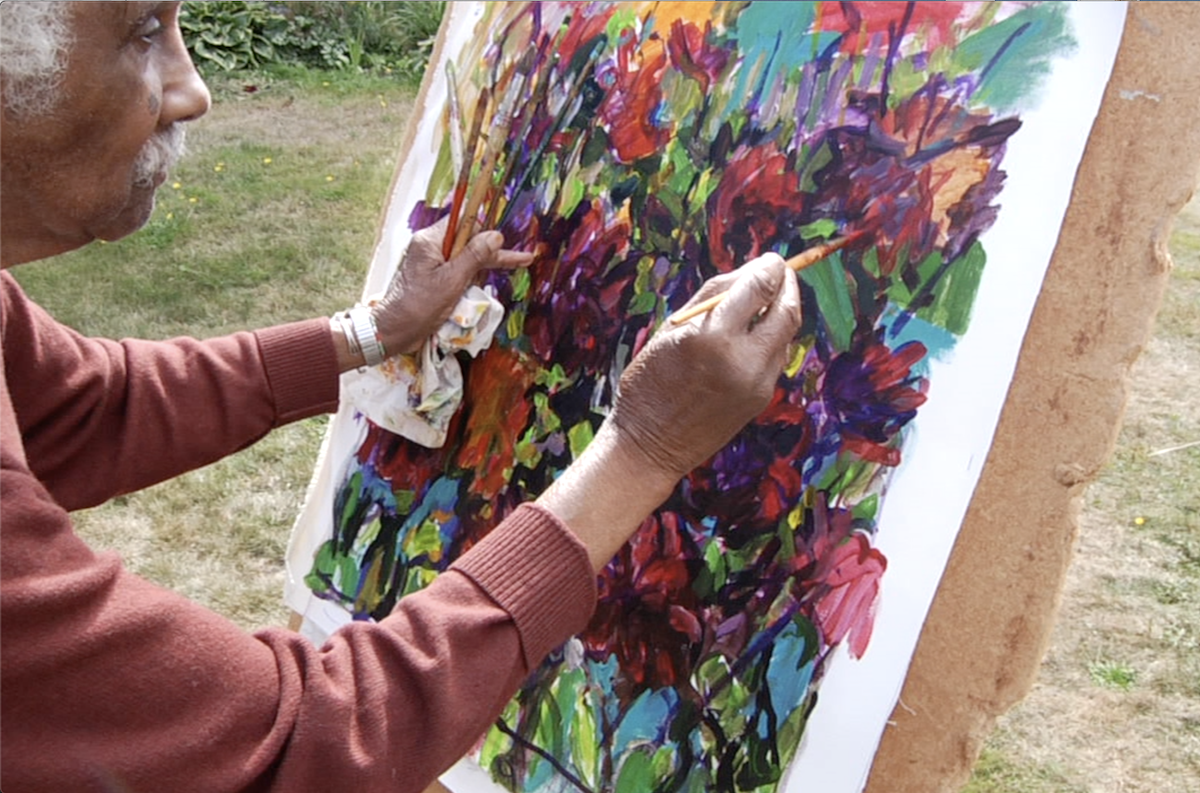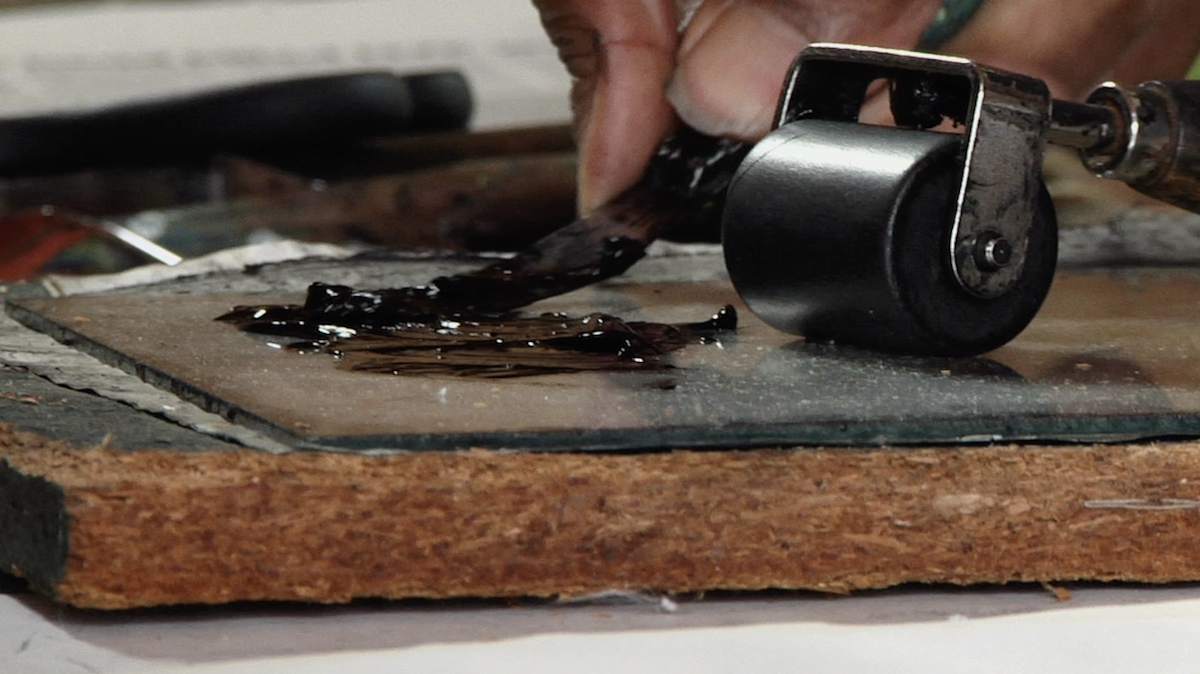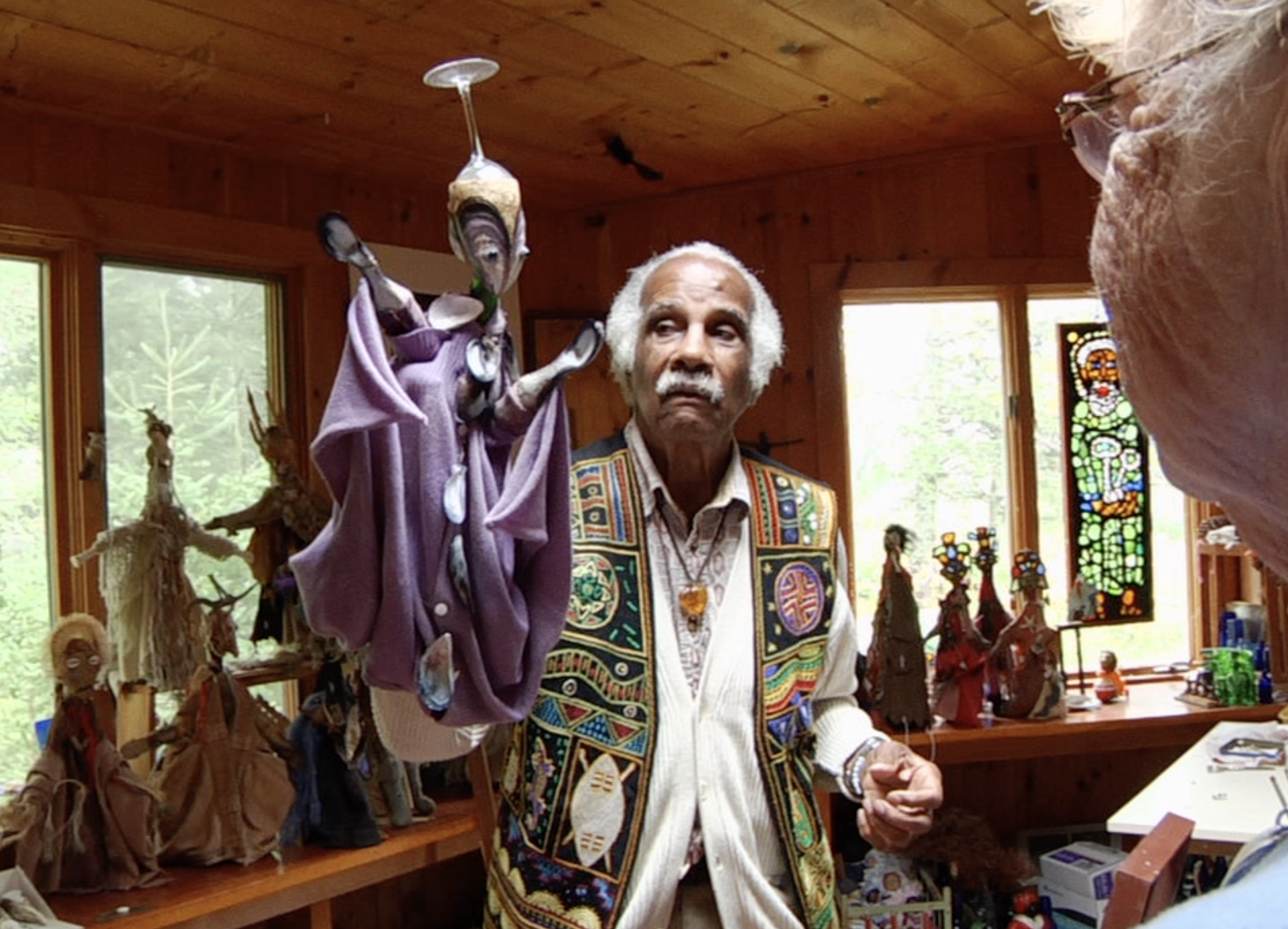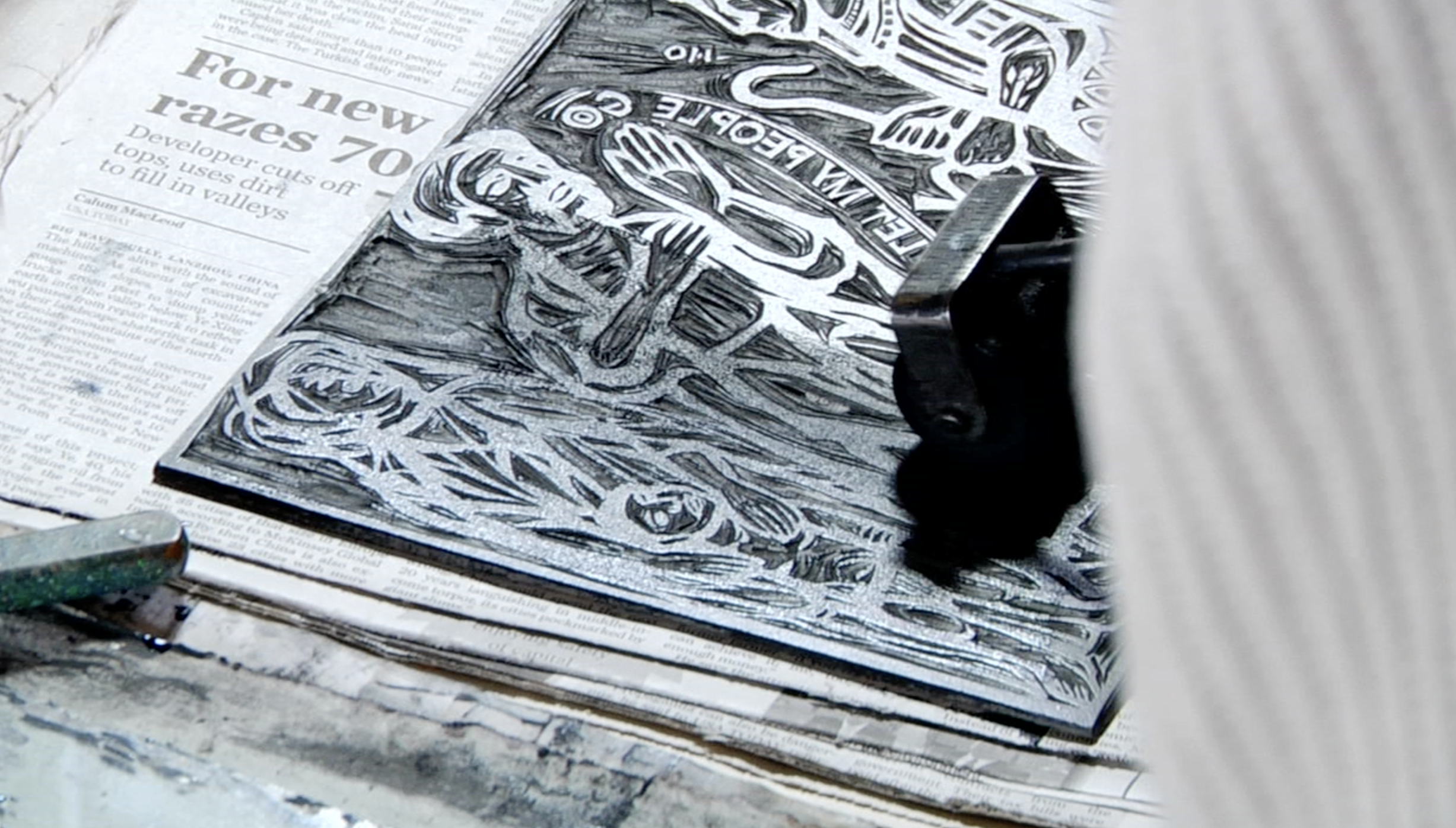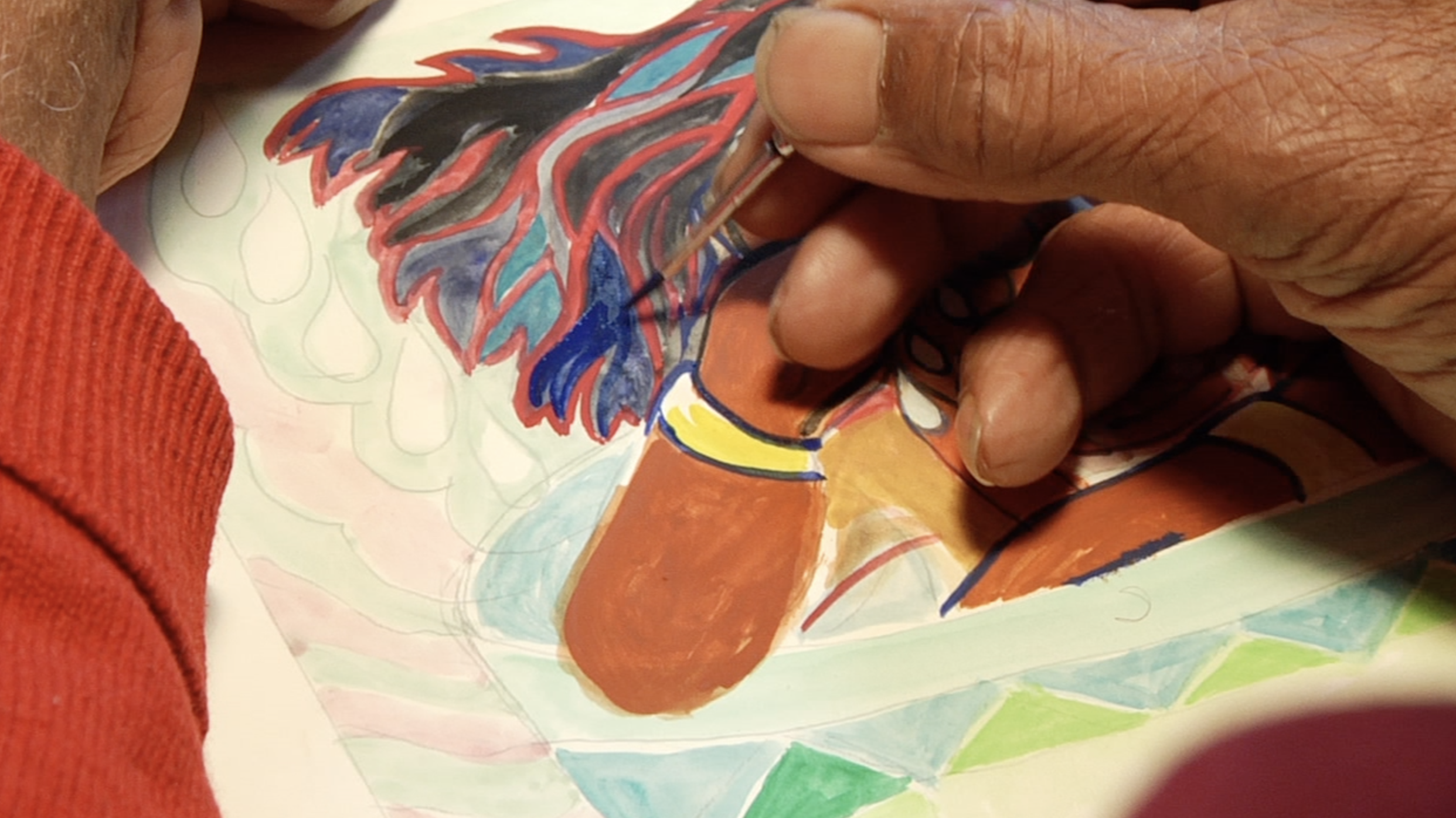GRADE 7-12 ENGLISH LANGUAGE ARTS and VISUAL ARTS
(click here to access printable .pdf file without images)
Table of Contents
Were You There? linocut by Ashley Bryan, Courtesy The Ashley Bryan Center
Introduction
Pre-Viewing Discussion QuestionsWatch and Write
Vocabulary: Reference Glossary
Post-Viewing Discussion Questions
Activities:
- English Language Arts: “I Know A…” Poetry Writing
-English Language Arts: Gordon Parks American Gothic
- Visual Art: Found Objects
Resources
THE SHORT FILM
I Know a Man … Ashley Bryan, 15:48 minute shortened educational version. Click here or on the title to access the film on Vimeo. These Guides are designed as companions to the film.
Introduction
“Ashley Bryan is a gentle activist, and I believe that history will remember him as one of the more important humanitarians of our time.”
— Mary Laury, Schoodic Arts for All, Executive Director
I Know a Man … Ashley Bryan paints a tender portrait of a uniquely American life. An exploration of the work and philosophy of 95-year-old artist Ashley Bryan, this short film is rich with connections to English Language and Visual Arts content areas. By providing ideas for discussions, creative activities, and resources for students and teachers, this Educator Guide serves as a springboard for deeper learning in response to the film’s topics and themes.
The film asks us to consider Essential Questions:
How do people find “purpose”? What makes life worth living? Does this change as we get older? If so, how?
What inspires artists to create? Can art be used to help people?
Each activity in this guide can stand alone or be done together in any order. Activities come complete with essential questions, material lists, and relevant core standards. Since you know your students best, we encourage you to adapt activities to serve your needs!
Pre-Viewing Discussion Questions
Time required: 5-10 minutes
Common Core State Standards: SL9.1, SL9.1c, SL9.1d*
Before the film, get students thinking about the Essential Questions. Try these prompts:
Do you know anyone older than 90 years old? What do you know about their life story? What questions would you like to ask a person who was born nearly one hundred years ago? (Goal: think about how life changes as people age, and the wisdom and challenges of a long lifetime)
Who comes to mind when students hear the word “artist”? Do they think mostly of visual artists, or musicians, writers, or actors as well? Can they think of any artists who make more than one form of art? (Goal: think about all the different ways people can make art, and think about their reasons for making art in different forms)
*NOTE: Here, and throughout this guide, 9th grade standards are used as a benchmark to assist your planning. The corresponding 7-8 and 10-12th grade standards can be substituted, and the activity adjusted down or up, to fit your needs.
Vocabulary: Reference Glossary
Below is a list of terms, references, and definitions your students may not be familiar with that appear in I Know A Man...Ashley Bryan. You may choose to hand out the list or review only the items that you anticipate will be new for your class.
Portfolio: A set of pieces of creative work intended to demonstrate a person's ability to a potential employer. (https://en.oxforddictionaries.com/definition/portfolio)
The draft: Mandatory recruitment into the military. (https://en.oxforddictionaries.com/definition/draft)
World War Two: A war (1939–45) in which the Axis Powers (Germany, Italy, and Japan) were defeated by an alliance eventually including the United Kingdom, the Soviet Union, and the United States. (https://en.oxforddictionaries.com/definition/second_world_war)
Hiroshima and Nagasaki: Two cities in Japan. Hiroshima was the target of the first atom bomb, which was dropped by the United States in 1945 and resulted in the deaths of about one third of the city's population. Together with a second attack on Nagasaki three days later, this led to Japan's surrender and the end of the Second World War. (https://en.oxforddictionaries.com/definition/hiroshima)
Spirituals: A religious song of a kind associated with black Christians of the southern U.S., thought to derive from the combination of European hymns and African musical elements by black slaves. (https://en.oxforddictionaries.com/definition/spiritual)
Sea Glass: Physically and chemically weathered glass found on beaches along bodies of saltwater. Sea glass is nature’s way of recycling bottles, jars, and other man-made glass! (https://bytheseajewelry.com/what-is-sea-glass-or-beach-glass/)
Langston Hughes: (1902–67), Black American writer. He began his career with The Weary Blues (1926), a series of poems on black themes using blues and jazz rhythms. (https://en.oxforddictionaries.com/definition/hughes,_langston)
Socrates: (469–399 BC), Greek philosopher. (https://en.oxforddictionaries.com/definition/socrates)
Post-Viewing Discussion Questions
Common Core State Standards: RI9.3; SL9.1
Time required: 5-10 minutes
Use the below questions for a conversation as a whole class, or split students into groups, assigning them each a question. If time allows, encourage students to represent their answers creatively, in both written and visual or performance form. (Ideas: posters, murals, paper sculptures, songs, or dances.) Anticipated responses are included next to each question in italics.
Beautiful Blackbird, by Ashley Bryan, courtesy The Ashley Bryan Center
The Ashley Bryan Center website (www.ashleybryancenter.org) describes him as a “humanitarian,” defined as “a person who seeks to promote human welfare.” Do you agree? Why or why not? (This question could be asked again after the activities, to see how students’ understandings change)
2. What was the deeper meaning to Bryan’s Beautiful Blackbird book? What do you think about delivering this message in the form of a fable? (Beautiful Blackbird sends an anti-racist message. If practical for your group, consider reading the book and having a larger discussion about fables and allegory.)
3. What obstacles did Ashley Bryan overcome on his journey to become a successful artist? Have those obstacles influenced his art? Can your students think of anyone else who makes art about these issues or obstacles? (Bryan’s art about racism and Black American traditions are informed by obstacles he overcame: growing up in poverty, segregation and racism when applying to college, getting
drafted for WWII).
Activity: “I Know A…” Poetry Writing
Time required: 40-50 minutes
Common Core State Standards: RL9.2, RL 9.10, and W9.3d
Essential Question: How do people find “purpose”? What makes life worth living as we age?
Suggested Materials:
Writing paper
Art paper
Colored pencils, crayons, or markers The Artist, by Ashley Bryan
I know a man, like a child
He loves to paint
He can paint anything he sets his heart to.
He knows that to have anything he loves
He can have it fair and forever
If he paints a picture of it.
He knows that to face anything that hurts he can do it.
Transform the sorrow if he paints a picture of it.
This is how he lives. This is what he does.
Activity:
Pass out copies of the above poem, featured in the beginning of the film, and read it aloud as a class. The first four words serve as the film’s title, and the themes relate to the Essential Question about aging. Ask students what they think the poem tells us about Ashley Bryan. Why does he love to paint?
Have students make a list of some of their own interests and favorite activities. (Ex: sports, art forms, social activities, school subjects)
Students should pick one item from their list, and write a new list of reasons why they love that interest. Encourage them to think deeply and creatively. For example, instead of saying riding a bike is “fun,” they could say “Biking makes me feel free” or “I like challenging myself to climb steep hills.” If students get stuck, consider supplying a list of sentence starters related to liking an activity. (Ex: It makes me feel _____, It helps me ______, I do it with _____, It has taught me _____)
Each student will use their list to write a ten-line poem about their activity, inspired by The Artist. They can use their reasons to inform their writing, need not worry about rhyme, and can write in third person, as Bryan does. Below is an optional template. Tip: Have students write a first draft and practice reading it to a partner. They should make edits based on how the poem sounds aloud, and then write a final draft.
___________________ by ___________________
I know a _____________________________
(description of themselves)
He/she loves ______________________
(favorite activity)
One line about how they like to do the activity
Three lines about why they like the activity
(Including how the activity makes them feel)
Two lines about how they hope to do the activity in the future
This is how he/she ______.
(verb)
This is what he/she ______.
(verb)
5. Arts Extension: Once poems are written, students can illustrate their final draft with drawings, colorful borders, or collages.
Activity: Gordon Parks American Gothic
“The unexamined life is not worth living.” -Socrates
Time required: 40-50 minutes
Common Core State Standards: RH9.1; RH9.6; RH9.9; RI9.2; RI9.6; RI9.9;
American Gothic, Washington, D.C. 1942, by Gordon Parks
Courtesy and copyright The Gordon Parks Foundation
Essential Questions: What does it mean to be “American”? How does that definition shift across time and people?
Materials:
Gordon Park’s photograph American Gothic (as seen at 1:40 in I Know a Man…Ashley Bryan) (https://iconicphotos.wordpress.com/2014/05/08/american-gothic-gordon-parks/)
Grant Wood’s painting American Gothic (https://www.artic.edu/artworks/6565/american-gothic)
Paper, pencils
ACTIVITY:
When describing his father’s immigrant experience, Ashley Bryan says they “gave him the mop and the broom (1:40), a reference to Gordon Park’s famous photograph, American Gothic. This activity has students compare the photograph to Grant Wood’s painting American Gothic, and then moves into a discussion of how the experience and definition of being an “American” changes across time and people.
Rewatch the section of the film from 1:39-1:52, where Bryan talks about his father’s immigrant experience.
Show the image of Gordon Park’s photograph. Ask students what they notice (students may mention that it’s from 1942, that the woman is holding a mop and broom, standing in front of a flag, it’s a photograph, in black and white).
Show students image of Grant Wood’s painting, American Gothic. Ask students what they notice (students may notice it’s from 1930, is a painting, is a white couple, man holding a pitchfork, standing in front of a barn).
Have students discuss what they think each artist was trying to say. Do the two works have different effects on us? How?
Remind students of Ashley Bryan’s quote, about how they gave his dad the mop and broom when he arrived in America. What is Ashley Bryan saying about his father’s experience as an American? How does this differ from Parks’ and Woods’ messages?
Next, challenge students to create their own artistic twist on “American Gothic.” Possible projects include photographs, drawings, digital art, or magazine collages. You could have printed copies available of both works for students to use as inspiration or to edit directly. What people, objects, or symbols might they include?
Post the 2018 versions of “American Gothic” around the classroom. What messages does each send?
Additional Resources:
Exhibition on Gordon Parks from November 2018-February 2019 at the National Gallery of Art in Washington, D.C.
Ashley Bryan with his puppets Babatu and Osaze made from found objects
Activity: Found Objects
Time required: 40-50 minutes
Common Core State Standards: W9.7; W9.9
Essential Question: What inspires artists to create? Can art be used to help people?
Required Materials:
Scissors
Glue or tape
White paper thick enough for gluing
• Pom poms or cotton balls
Straws or toothpicks
Legos or old blocks
Pebbles, twigs, leaves, flowers or shells
Newspapers and magazines
Felt, foam, or fabric scraps
Sea glass
Broken toys, odds and ends (anything that can be repurposed)
Anything else you can imagine!
Possible Materials:
Recycled bottles, containers, and boxes
Foil, plastic wrap, tissue paper
Toilet paper and paper towel rolls
Old puzzle or game pieces
Bottle caps or old buttons
Recycled cardboard/paper
Yarn, string, or pipe cleaners
Paper plates, cups, or bowls
Activity:
Ashley Bryan uses found objects to make puppets. Found objects are natural or man-made objects that are found by an artist and repurposed into an artistic material. Often, artists will use objects to inspire their work, taking notice of their shape, color, or texture to spark their imagination. Recycling existing materials helps both the art and the Earth’s environment!
You might choose to offer the option to make either a puppet or a portrait, or structure this activity around one form in particular. Your available materials can help guide this decision. Large materials like boxes, bags, cardboard, and fabric make good bases for puppets. Smaller materials, assembled on canvas or poster board, are best for portraits.
Prep: Asking students to aid in the object finding process can be helpful for you and fun for them. Search around home or your school for anything that seems interesting—think outside the box! Plan how to best arrange objects/supplies “buffet style” in your classroom, so students can select the objects most inspirational to them.
Each student should imagine a famous person, historical figure, or fictional/mythological character who inspires them. They should spend some time looking at photos or doing other research about their chosen person. You might choose to narrow this prompt by focusing on a time period or fictional work you are studying.
Give students no more than ten minutes to select found objects from the “buffet” to use for either a puppet or a portrait of their chosen person. Encourage them to not think too hard about what they will use each object for—instead choosing objects they are inspired by, or that remind them of the person.
Use the remaining time to construct the puppets and/or portraits. Portraits can be assembled by gluing objects to poster board, foam core, or another thick material. For bigger objects, hot glue may be necessary.
Have each student write an “Artist Statement” about their puppet or portrait. Why does their chosen person inspire them? Which of their found objects have special meaning related to the subject?
Display the finished portraits and/or puppets around the room. Can students tell what person inspired each artwork? What were some of the most interesting object choices?
Puppet Show Extension: If students made puppets, give them a chance to use them in performance! Students can work in groups of 2-3 to script, rehearse, and perform a short piece featuring their puppet characters. Depending on the people who inspired their work, they might choose to structure the scene as a conversation between different famous figures, or a re-enactment of an event in history or literature. Encourage students to create a “stage” for the puppets that hides the arms of the puppeteers, using large boxes, desks, or paper.
Resources
The Ashley Bryan Center Website: https://ashleybryancenter.org/index.html
Hanoch Piven, Found Object Portrait Artist: http://www.pivenworld.com/
Found Object Art Information: https://www.tate.org.uk/art/art-terms/f/found-object




